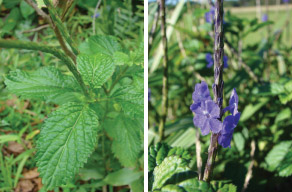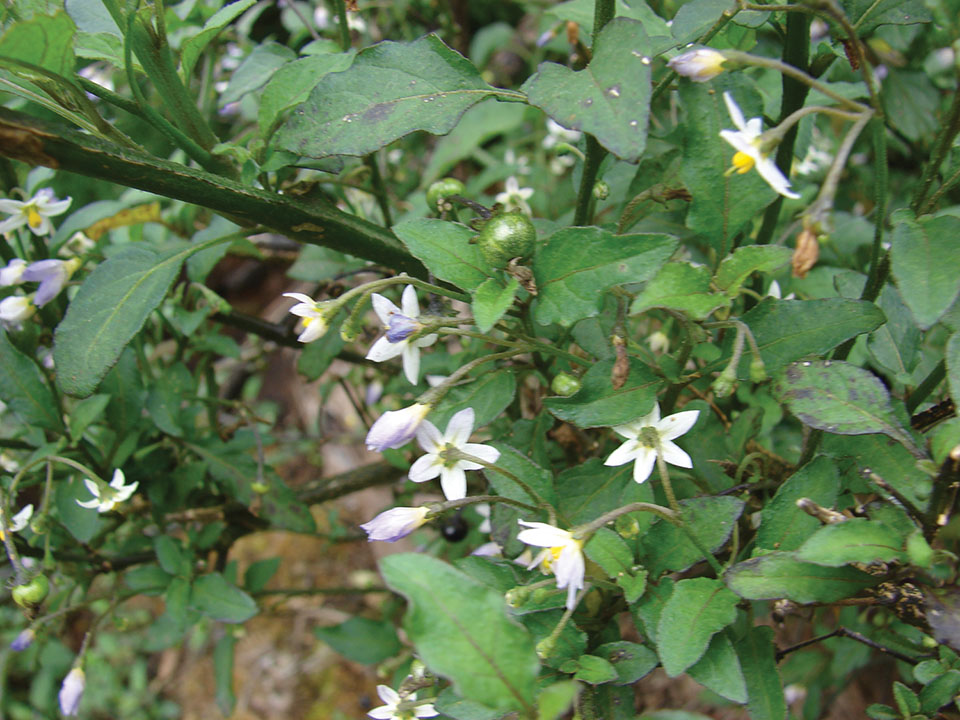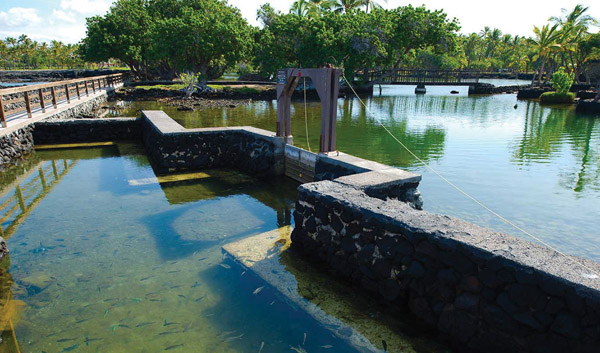
Fishponds in Hawai‘i: A Small Scale Understanding
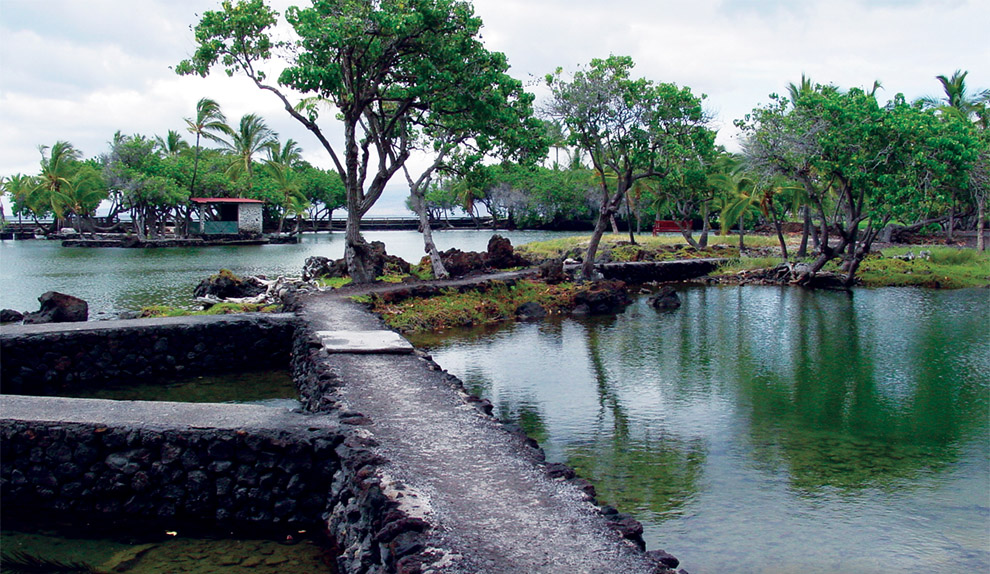
By Barbara Fahs
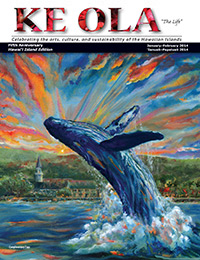
Sustainability is a major buzzword today. Growing food, harvesting power from the sun, buying locally produced products to rely less on foreign imports at the supermarket are values and practices that many Americans understand clearly today. Wherever our ancestors hailed from, sustainability was far more than a buzzword in former times—it was paramount to the continuation of life.
Consider the Irish potato famine in the mid-19th century. So reliant were the citizens of that era on potatoes that when a disease struck the crops people had nothing to eat and they began to starve.
The ancient Hawaiians are a perfect study in sustainability. Geographical isolation required that they produce all of their food, clothing, and building materials. In addition to the 24 life-sustaining plants the ancient Polynesians carried in their canoes, their practice of building fishponds guaranteed a steady supply of high protein food for king and commoner alike.
Fishpond History, As We Know it Today
Fish farming became widespread throughout the Hawaiian Islands as early as the 14th century, before other Polynesian population groups adopted the practice. Fishermen primarily collected fish from their canoes and from the shore, while fishponds supplemented their take and helped to feed a growing population during times of inclement weather, drought, and crop failure.
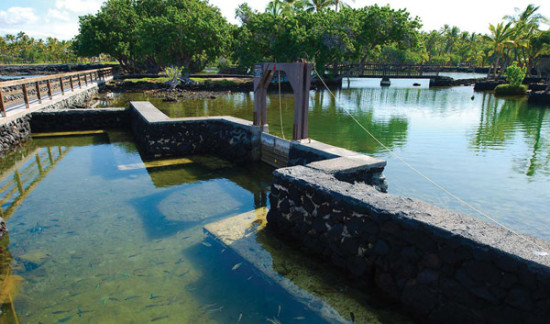
“In a culture that honored the earth’s abundance, fishponds symbolized the connection Hawaiians forged between themselves, the ‘āina (land), and the akua (gods),” according to HawaiiHistory.org.
Fishponds existed on all of the Hawaiian Islands, with the majority occurring on Moloka‘i. The smallest number is on Hawai‘i Island because the rocky coastline and the absence of reefs and lagoons made it difficult to build fishponds in many areas.
The legends and myths of ancient Hawai‘i are numerous and have provided us with many clues about historic events. Hawaiian mythology credits the god Ku‘ula-kai as the architect of the first fishpond, in Hāna, Maui. Some myths mention miraculous little menehunes as the builders of some ponds, such as Alekoko and Nomilu on Kaua‘i. According to the myths, these diminutive prehistoric residents completed huge ponds in only one night.
Not everyone enjoyed the bounty that prehistoric fishponds offered. They were protected by restrictive kapu intended to limit both poaching and polluting. Kapu protected fish during their spawning season. Many fishponds were created for the ali‘i, or ruling class, and a commoner who took even one fish from a restricted pond could face a punishment of death.

Lower: The remains of the wall after tsunami and high surf destroyed it, Mar 13, 1972. photo by Neal Crozier
Types of Fishponds
Fishponds were specific in their design and construction. Four major types of royal ponds, or loko, are known to have existed.
-
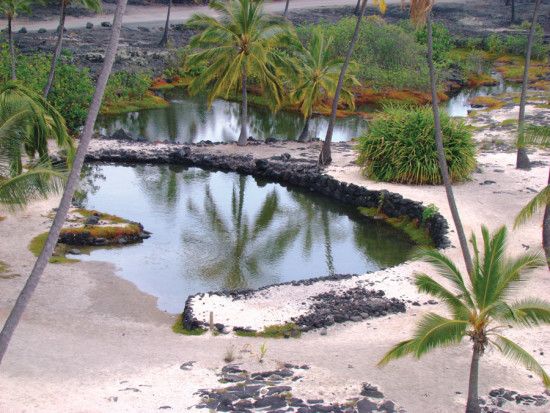
Pu‘uhonua O Hōnaunau. NPS photo Loko kuapā are walled shoreline ponds surrounded by a massive stone seawall. They are the most common type of pond: we know of approximately 127 loko kuapā throughout the Islands. Sluice gates, or mākāhā, were present in at least one area to keep fish in and let fresh water circulate. This type of pond is exclusive to the Hawaiian Islands and is not found in other parts of Polynesia. Several of these ponds still exist on the Kona coast and other areas of west Hawai‘i Island. On O‘ahu, at He‘eia, the largest known loko kuapā has a 5,000-foot-long seawall that encloses 88 acres.
- Loko pu‘uone also are shore ponds containing brackish water. They are often natural ponds behind a beach or sandbar that serves as a barricade between the pond and the ocean. A channel was usually dug to connect this kind of pond to the ocean.
- Loko kāheka are brackish anchialine ponds common in west Hawai‘i. They are found slightly inland, yet are affected by the ocean’s tides due to subterranean passages.
- Loko wai are freshwater ponds found in inland areas and are often natural rather than constructed.
Types of Fish Raised in Ponds
If you were to stroll through an ancient Hawaiian village with a fishpond, you would have seen many ‘ama‘ama (mullet) and awa (milkfish). Many other species were also raised, including another mullet called an ‘anae, āhole (sea-pig), ‘ōpae (shrimp), ‘o‘opu (guppies), and puhi (eels). Sometimes other fish entered the pond on their own: common residents included ulua (giant trevally), kāhala (amberjack), kūmū (goatfish), manini (surgeon fish), ‘ō‘io (bonefish), and uhu (parrotfish), according to HawaiiHistory.org.
The size of the annual fish harvest from a pond depended on the pond’s size and the kinds of fish that inhabited the pond. Estimated amounts for each acre of a pond’s size range from 300 to 500 pounds.
Methods of Harvesting Fish
When harvest time arrived at strictly prescribed times of year, specially designated fishermen used hand nets, dip nets, seines, or surround nets to capture only the pond’s mature residents. A common method was the use of scoop nets that fishermen situated inside the pond near the mākāhā, or sluice gate, during an incoming tide because that’s where the largest fish congregated.
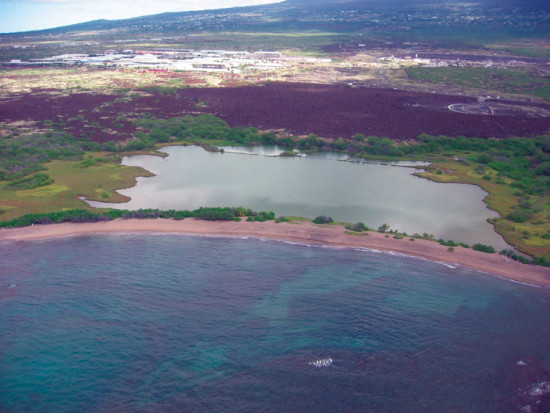
Another method of gathering fish involved the use of certain plants that caused fish temporary stupefaction or loss of consciousness. Similar to drunkenness, fish would float to the surface of the pond making it extremely easy for fishermen to spear them or collect them in nets, like a pre-colonial “shooting fish in a barrel.”
Ancient fishermen pounded the bark, leaves and roots of the native Hawaiian plant ‘ākia (Wikstroemia uva-ursi), or hillside false ‘ōhelo, together with bait and then dumped the mixture into the pond they intended to harvest. This plant is a small perennial shrub that contains narcotic chemical properties that caused only cold-blooded animals to lose consciousness, so when humans later ate the fish, they did not experience the same effect. Native Plants Hawaii website warns, however, “It is probably best to side with caution and avoid ingesting any parts of ‘ākia until sound information is available.”
Status of Fishponds Today
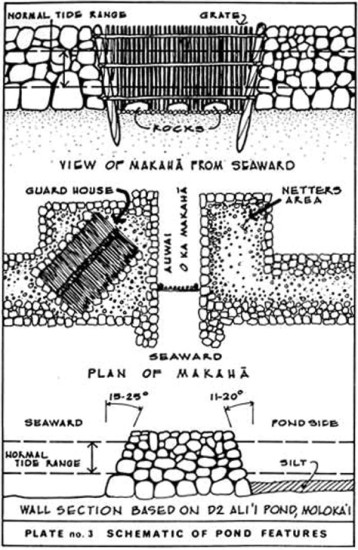
Many ancient fishponds no longer exist due to a number of factors: “Warring chiefs, siltation from upland runoff, overgrowth, introduced marsh plants and grasses, general disrepair, and pollution,” according to nps.gov. On Hawai‘i Island, the lava flows of 1801 and 1859 destroyed several fishponds on the Kona side. Additionally, the site states, “Earthquakes, landslides, faulting, storms, and tsunami (tidal waves), have also affected ponds.”
Thanks to resorts situated along the Kohala and Kona coastlines, we can visit some of the ancient ponds today. Because fishponds existed before the hotels moved in and transformed coastal areas, we have the special opportunity to see beautifully restored ancient ponds at locations such as the Four Seasons Hualalai and the Waikoloa Beach Marriott.
Four main fishponds and three smaller ponds are part of the property that the Mauna Lani Bay Hotel & Bungalows now occupies. Two ponds are the loko kuapā type, with the remainder being loko kāheka. Known collectively as Kalāhuipua‘a, these ponds cover 11 acres and have been meticulously restored to their former greatness, which would have pleased King Kamehameha I, because these were among his favorite ponds that pre-date his reign. It is said that the fish raised at Kalāhuipua‘a were of such high quality that Kamehameha had kūkini (runners) who brought these delicacies to him.
Think big when you imagine Hawaiian fishponds: the largest pond at Mauna Lani, Lahuipua‘a, is nearly five acres in size and reaches a depth of about 18 feet. In 1973, before the resort was built, Dr. Patrick Vinton Kirch of the Bishop Museum identified these ponds as historic sites and dated them as far back as 250 BC, according to samples he took from the floors of the ponds. This date does not imply that humans existed here that long ago; many fishponds began because of naturally occurring conditions.
At Mauna Lani Resort, visitors can experience a unique tour of these restored fishponds, which Danny Kaniela Akaka, Cultural Specialist leads three times each week. More than 20,000 visitors have learned about this important slice of Hawaiiana from him. Check with the hotel for the current tour schedule.
The two National Historical Parks in west Hawai‘i have easily accessible fishponds that visitors can see.
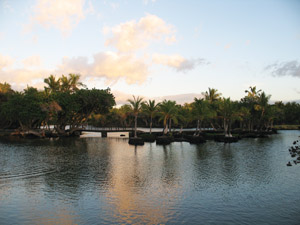
Pu‘uhonua O Hōnaunau National Historical Park includes two ancient ponds of the loko pu‘uone type. The north pond and possibly the south pond were used in former times. According to Adam Johnson, Chief of Integrated Resources Management, these ponds are relatively small and are situated slightly inland. They are also anchialine pools fed by underwater springs and are subject to tidal influence. These ponds were possibly used to raise mullet or simply to store fish.
“We are currently restoring our ponds and attempting to eradicate the invasive tilapia and mosquito fish that inhabit them,” Johnson explained.
A large loko kuapā can be found at Kaloko-Honokōhau National Historical Park near Kailua-Kona. Stacked stones form a seawall 250 yards long that encloses the mouth of a small bay and a large mākāhā illustrates how this feature of ancient fishponds served to keep fish in and out. The National Park Service is restoring the seawall and plans to reestablish this pond for active aquaculture. Two other fishponds exist at Kaloko-Honokōhau: ‘Aimakapā, a loko pu‘uone, and the ‘Ai‘opio fishtrap, which is also undergoing restoration.
Obstacles to Restoration: Permitting Process and Cost
It is difficult to obtain permission to restore an ancient fishpond today. The process that any company or group must go through involves obtaining up to 17 permits from Federal, State, and Hawai‘i County agencies, according to an October 2013 article in Hawai‘i Tribune-Herald. Because of the complexity of the permitting process, years can easily pass before final permission is granted, and it can cost up to $80,000 in time and wages required to navigate the many complicated forms.
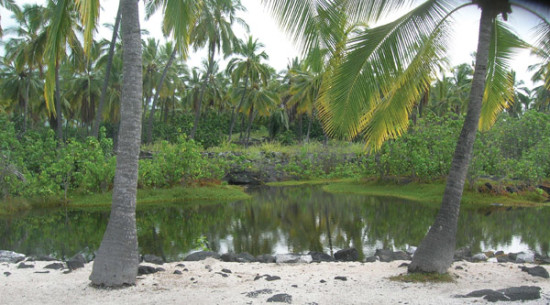
The promising news is that the Department of Land and Natural Resources Office of Conservation and Coastal Lands is currently proposing a “streamlined permitting process for some fishpond projects, depending on the project’s scope, materials to be used, location, and potential environmental impact,” according to their final environmental assessment document, which has received letters of support from The Office of Hawaiian Affairs and state legislators.
The struggle continues, as communities and fishpond practitioners seek to maintain and rebuild known fishponds in their vicinities. For small organizations with limited funds, a simplified process exists whereby the maintenance of a pond lies outside regulations if those doing the work use only elbow grease, hand tools, and traditional materials. ❖
Contact Mauna Lani Bay Hotel & Bungalows: 808.885.6622, MaunaLani.com.
Contact Pu‘uhonua O Hōnaunau National Historical Park: 808.328.2326, Nps.gov/puho/index.htm.
Contact Kaloko-Honokōhau National Historical Park: 808.326.9057, Nps.gov/kaho/index.htm.
Contact writer Barbara Fahs: hiiakas@lava.net

